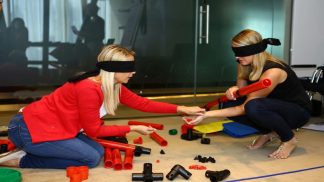Activities for team building: the best games and exercises for team development
Team development activities are games and exercises designed to build interpersonal competencies like communication, cooperation, leadership, and adaptability.
These activities are popular in corporate settings because they equip personnel with skills that are invaluable in the workplace, setting teams up to achieve better results than those who can’t work together.
This blog post rounds up some of the best team-building activities, from 5-minute activities to break the ice, right through to advanced activities suited to corporate team-building events.
Here’s what we’ll cover:
- Team building competencies
- Quick team building activities
- Free team-building activities
- Outdoor team-building activities
- Corporate team-building activities
Team building competencies
The phrase ‘team building’ is the tip of a very big iceberg, and you’ll gain more from having a deeper understanding of the skills you’re looking to develop.
This level of understanding will help you to find activities best suited to the skills in question, and to curate sessions with a higher likelihood of creating lasting outcomes.
Here are some common team-building competencies:
- Teamworking: how well participants can work together
- Leadership: how to lead, how to decide who should lead, and also how to follow
- Communication: exchanging information efficiently, giving and receiving instructions, and so on
- Defining success: clarifying constraints and objectives to ensure a constructive direction of movement
- Setting objectives: outlining direction of movement
- Setting targets: attaching measurable outcomes to tasks
- Creating a vision: generating buy-in for a direction of movement once it’s agreed upon
- Generating ideas: coming up with creative and viable ways to approach a task
- Planning: formulating a strategy for completing a task, estimating completion times
- Delegation: allocating work out amongst team members based on ability and resource
- Inter-group working: how to collaborate with other groups, how to avoid competing with other groups
- Revising plans: how to use new information to evaluate and refine plans without losing sight of the goal
- Taking responsibility: how to take ownership of a task and bear responsibility for its success
- Identifying and prioritising objectives: establishing and keeping track of objectives, some of which may be in opposition (company vs departmental, for example)
- Creating a team charter: determining values, agreeing timeframes, allocating roles, defining responsibilities and so on
Before deciding which team-building activities to use, we recommend having a think about what you’re trying to achieve.
Not all activities are effective in developing all competencies, and creating a successful program of team-building events relies on choosing the activities that align with your desired outcomes.
Looking for a personalised activity recommendation? Then click here.
Quick team-building activities
Sometimes you need a simple team-building activity to break the ice or get people in the zone.
Generally speaking, these activities work closer to the surface level, and may not reveal or develop anything particularly deep.
When you might use quick team-building activities: these are ideal for running at the start of a session, especially with a group who don’t know each other. They’re a bit of fun and they get the cogs turning.
Scavenger hunt
Maybe you played this as a kid: an adult sends you off to find a list of items, either on your own or as a team. The first person (or team) to return with the items wins.
This exact same concept works great as a team-building activity, and you can play it just about anywhere.
Scavenger hunts also work as virtual team-building activities: simply group people together then tell each group to find the required items wherever they happen to be. Effective teams will strategise, figuring out who’s best placed to get what, whereas less effective teams will just scatter.
Competencies developed: planning, communication, delegation, prioritising objectives
Keep the balloon up
Here’s another game that’s popular with kids, and for good reason. This is quick, fun, easy to set up, and a great way to get people engaged.
You can either pit two teams against each other with the winner being the last team to touch the balloon before it hits the ground, or get one team to keep the balloon up for as long as possible. The dynamics will vary in each format, so don’t be afraid to experiment.
And if your participants aren’t taking things seriously, show them this video of the world’s first Keep the Balloon Up World Cup victory:
Competencies developed: communication, leadership
Count the beans
Get a few big jars of beans and tell teams to count them. Sounds simple, but the approach they take can reveal a surprising amount. Will they jump straight in, or will they take a moment to figure out an efficient strategy first?
There are a couple of ways to mix this activity up as well:
- Get teams to guess beforehand, as a way to practice estimation skills and group decision making
- Include different types of beans in the jar and either ask for totals of each type, or leave it up to the teams to decide whether or not to include this in their strategy
Competencies developed: planning, communication, estimating, defining success, setting objectives
Two truths and a lie
In this game, an individual or a group read three statements about themselves. One is true, the others are false. The other team members, or the other teams, must decide which is true by asking questions and gauging reactions.
This mainly works as an ice breaker, but it may give some insight into how well participants can mask the truth… Always useful to know!
If you need a demo, here’s Will Smith playing the game on Ellen:
This works great as an online team-building game, too. The rules are exactly the same.
Competencies developed: communication, generating ideas
Back drawing
This activity is great because you can easily alter how ridiculous it becomes. The traditional format is this: one person uses their finger to “draw” a picture on the back of the person in front of them, who then has to guess what it is. Correct guesses win points.
If you line a few people up though, you can turn it into a sort of Chinese Whispers, where the person at the front of the line has to guess a drawing that’s been through several rounds of interpretation.
Keep an eye on whether participants keep their cool, and how they communicate with each other if not.
Competencies developed: teamworking, non-verbal communication
Quick team-building activities with MTa
If you want quick team-building activities that do work on a deeper level, check out the 10 short activities in the MTa Team Kit.
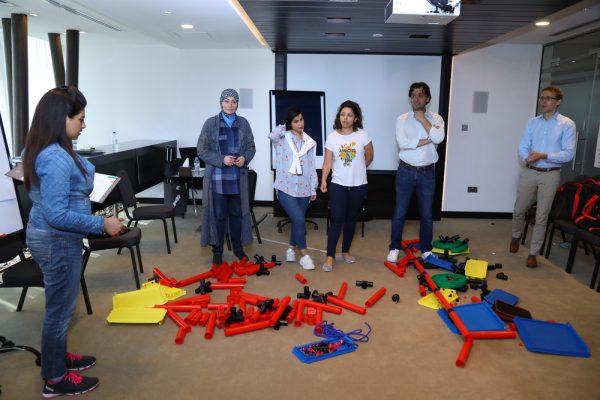
These short, easy-to-use experiential training activities will stimulate thought, energise your group through activity and movement, and provide opportunities to practice effective team working.
Free team-building activities
As with quick team-building activities, free ones are prone to limitations in terms of depth and quality. This isn’t always the case, and an awareness of what each activity aims to do will help you figure out whether or not they’ll be useful.
When you might use free team-building activities: when you’re running a team-building event with a low budget, or to bulk out an event which includes some big-ticket items.
Egg drop
Disclaimer: you’ll have to buy a box of eggs so it’s not technically ‘free’, but the cost is very low.
Get teams to come up with a way of keeping their egg safe and uncracked after being dropped from a height – ideally first floor or higher. It’s up to you which materials you let them use, how long they have to build it, and how to decide the winner if all the eggs break.
Competencies developed: planning, setting objectives, generating ideas, leadership
Orienteering
In orienteering, teams have to find their way around a marked course with just a map and a compass. This is a great way to test team skills, as there are several things you need to do to succeed.
Firstly, groups need to find out who has the relevant skills. Then they need to decide between them who will take responsibility for which part of the activity. And finally, they need to actually complete the course.
You can either set up your own orienteering course or use one of the permanent courses set up by Orienteering UK.
Competencies developed: leadership, teamwork, planning, communication, revising plans, taking responsibility
Pop quiz
While the lockdown craze has subsided a little now, this is still a nation of pub quizzes. Something about challenging each other with obscure facts and minor trivia really gets us going.
And done properly, a pop quiz can make a great free team-building activity. Whether at the pub after work as a team bonding social, or in a team-building day where teams must compete against each other to pool knowledge and come out on top.
In a corporate setting you could theme the questions around company policy or situations employees are likely to encounter – a fun way to learn usually improves memory retention.
Competencies developed: teamworking, taking responsibility, group decision making
Blindfolded obstacle course
Head to any outdoor team-building centre and you’ll probably find an obstacle course of some sort. Whether it’s a few tyres on the floor and a couple of walls to climb over, or a full-fledged assault course through a patch of woodland.
As team activities, such obstacle courses can be very effective. People have to work together to get through: helping people out if they’re struggling, discovering new talents, generally having fun together.
Introduce a blindfold to the mix and you’ve got an even bigger challenge: a group will have to work a lot harder to get their blindfolded team mate through the obstacle course. Effective communication becomes paramount, and the higher stakes make people more invested.
Competencies developed: communication, leadership, teamworking,
Free virtual team-building activities with MTa
If you’re looking for a free virtual team building activity, head over to MTa Immersion and check out our Zin Obelisk free trial.

This activity is a great introduction to online team working, and also to experiential learning activites: those which are designed to create lasting learning outcomes through a participant-led review process.
Corporate team-building activities
Sometimes you need team-building activities that are designed to simulate environments that participants might encounter in their roles. These activities need to be built on more advanced theoretical foundations to ensure they offer effective opportunities to develop the skills in question.
For this section we’ve included a couple of activities from the MTa Team Kit: one of our flagship products which includes 16 activities designed from the ground up to develop crucial competencies.
When you might use corporate team-building activities: when you’re looking for more advanced activities that have the theoretical underpinning required to instil lasting change on key competencies.
Corporate team-building activities with MTa
Over the Bridge is a fun team building activity that introduces fundamental concepts
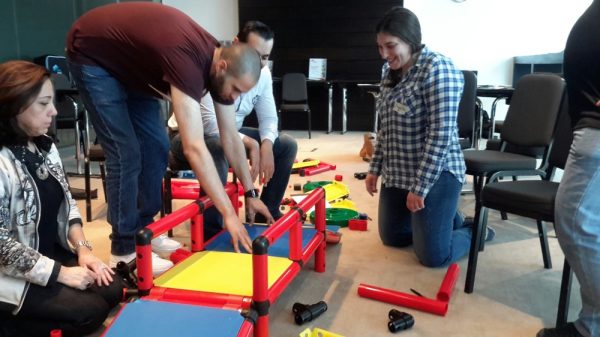
Competencies developed: effective team working, leadership fundamentals, awareness of customer needs
In The Frame, builders must put together a very complex design, but they’re not allowed to see it
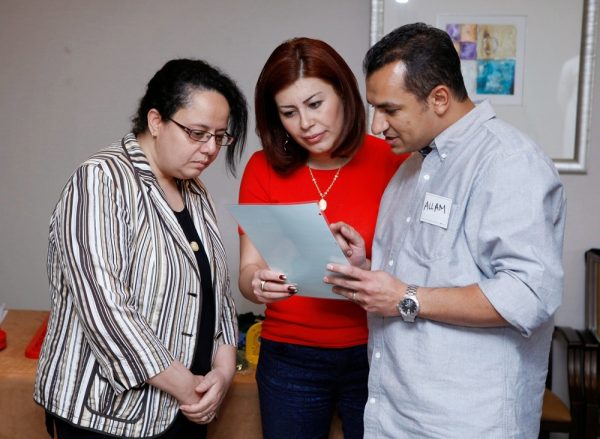
Competencies developed: considering others’ needs, keeping the bigger picture in mind, developing trust, testing assumptions, inter-group working
The Trailer is an advanced team-building exercise where limited resources and physical separation of teams ramps up the challenge.
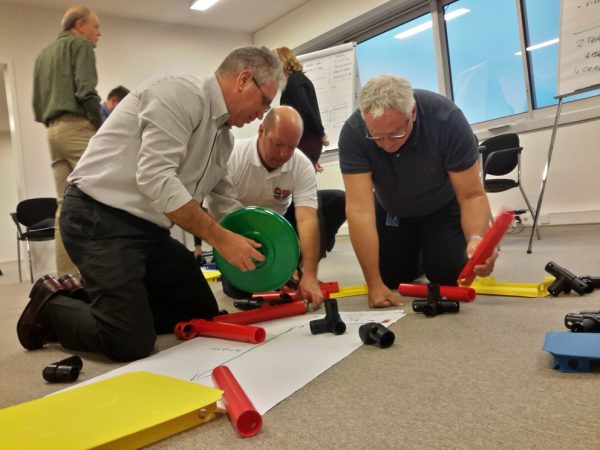
Competencies developed: utilising team members’ skills, delegation, taking personal responsibility, team leadership
Outdoor team-building activities
A reliable way to increase engagement with team-building activities is to move them outside, when the weather allows. Working through a fun activity in the sunshine is far preferable to doing it in an office room!
Other activities only really function outdoors, so depending on your venue and the goals of your session, you might look to only include outdoor team-building games.
When you might use outdoor team-building activities: when the weather is unexpectedly good and space allows on a day you’ve planned an indoor team-building session, or when you’re deliberately planning an outdoor session.
Command tasks
We’ve written a big blog post about command tasks for cadets: many of the activities in here are perfect for outdoor team-building sessions. We recommend taking a look and picking out a few that you like the sound of.
Orienteering
Some of the activities mentioned above in this piece work well, too. Orienteering, for example, is an ideal outdoor team-building activity. Participants spend a lot of time outdoors, usually somewhere fairly nature-heavy although it can be done in urban contexts.
Obstacle course
Again, the obstacle course mentioned in the previous section lends itself perfectly to outdoor team-building days. Many team development centres will already have one set up.
Marble run
Disclaimer: you can use any ball, not just a marble.
Give participants a bunch of equipment – pipes, sheets of material, boxes, fabric and so on – and get them to transport the marble (or ball) from A to B. A should be quite far away from B, and the ball should travel the whole distance without any humans touching it.
Competencies developed: planning, teamwork, communication, generating ideas, refining strategies
Outdoor team-building activities with MTa
Some of the activities in the MTa Team Kit are well-suited to being run outdoors.
In Rectangle, teams must build as big a rectangle as possible. Sounds easy, but there’s a twist…
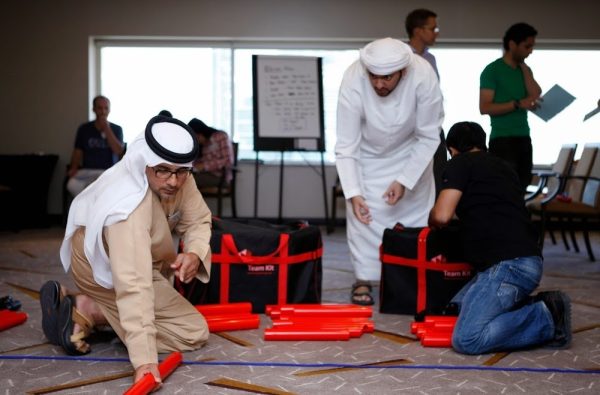
Competencies developed: teamwork fundamentals, establishing clear objectives, planning before acting, revising plans, listening, offering ideas
The Tower tests assumptions: two teams will both do better if they work as one, but only to a point…
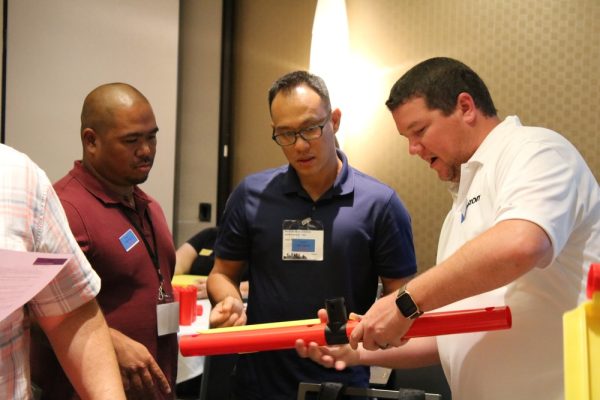
Competencies developed: building and maintaining trust, working with others to maximise performance, delegating, inter-team communication
Conclusion
Team building is a vast concept with many constituent competencies, and you’ll see the most success if you have a firm idea of the specific competencies you’re looking to develop.
Many team-building activities are designed to be a bit of fun, to bring down barriers, and to help participants work towards a shared outcome. But not all of these activities function on a deeper level.
To be truly valuable, team-building activities should offer lasting learning outcomes. Participants should carry forward the lessons learned into their work, whether they realise it or not.
Activities that use the experiential learning methodology are designed to work on this level. Through a participant-led review process, people are able to reflect on what’s happened, the role they played in it, anything that hindered performance, and ways that next attempts could be improved.
Our range of experiential learning materials includes physical and virtual activities, including the MTa Team Kit, which features 16 activities whose solid theoretical underpinning enables development of crucial team competencies.
We’re also happy to help you find the right activities or kits to meet your goals. Drop us a message below or fill in the form on our contact page.

